Computerized 3-D images with spectral domain OCT can help diagnose optic nerve diseases
The computerized 3-D imagery possible with the newer spectral domain optical coherence tomography generates images showing elevation of the optic nerve head in a new and interesting format. This ability to easily detect the elevation is helpful when determining the underlying pathology and the resulting changes in the surrounding retinal tissue. OCT has the capability of detecting changes in ocular tissue thickness in the micrometer scale of sensitivity.
This method of computerized 3-D imagery is essentially a point-by-point determination of the optic nerve head and surrounding retinal thickness collected within the entire data cube.
To produce such an image, the scanning device must be able to collect a massive amount of data that can be analyzed and displayed in a point-by-point image. It must be relatively fast so movement artifacts are minimized. Also, fast collection is necessary to facilitate patient cooperation during the testing event.
Reflective interfaces
Such 3-D imagery requires a reference point to determine relative distance calculations. The reference point/points (plane) must be easily found by the instrument, and highly reflective interfaces are ideal for such determinations.
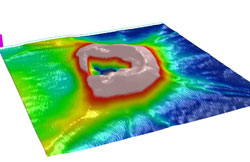 Optic neuritis with swelling over most of the disc in the right eye. A small optic disc cup is present. Images: Jones W |
The two best reflective interfaces in OCT scanning are the internal limiting membrane (ILM) and the retinal pigment epithelium (RPE). The distance from the ILM to the RPE can be easily determined by OCT, and any change in elevation or depression in the optic nerve head or retina will be displayed in a 3-D fashion in the scan block. Optic disc measurements are determined by the distance from the level of the RPE (no ILM over the optic disc).
Small differences in distances are greatly enhanced on the 3-D data cube. Therefore, even a slight elevation is pronounced on the displayed image. This enhancement is important, for it allows one to easily see optic nerve head elevation and optic cup depression. Any white-topped elevations (high elevations) of the optic disc need to be examined for potential pathology or anatomical reasons.
Color coding
The relative distances between the two reference points (plane) have been given a color code system. Zero microns (µm) is black, 100 µm ranges from dark gray to light gray, 200 µm ranges from light blue to dark blue, 300 µm ranges from light green to dark green, 400 µm ranges from yellow-orange to light red, 500 µm is red, and greater than 500 µm is white.
We refer to elevated optic disc tissue in the white zone on the 3-D scan as “snow-capped” mountains to the patient. Be aware that small crowed discs may be mildly elevated and may show white peaks or ridges on the disc surface.
 Papilledema with swelling over most of the optic disc in the right eye. A small optic disc cup is present. Note that the juxtapapillary retina is irregular in appearance due to edema (especially temporal). |
Diagnosing optic nerve diseases has become easier using this 3-D disc method. It is also much easier to explain to the patient the changes in the optic nerve due to a disease condition or acquired anomaly.
How the instrument works
The instrument used to produce such 3-D images is the spectral domain Cirrus-HD OCT (Carl Zeiss Meditec, Dublin, Calif.). It takes 27,000 A-scans per second, with an axial resolution of 5 µ, a transverse resolution of 15 µ and a scan depth of 2 mm with 1,024 data points. The macular cube 512 x 128 Combo has 200 horizontal line scans that comprise 512 A-scans each.
The capture method chosen for the 3-D disc is the macular cube scan. This scan is able to create a thickness map of the tissue from the ILM to the RPE in the macular area.
Nonstandard application
My method is not a standard application of the instrument but can be easily performed. After obtaining the best view of the macular area by centering the scan in the pupil and achieving the best focus (maximum clarity), click on the bisected aiming cube square and drag it a small distance away from the small green aiming target cross. Then click on the small green cross and drag it laterally to place the optic disc in the central area of the viewing screen. Next, click and drag the aiming square over the optic disc so the crosshairs are bisecting the disc.
Adjust the height of the OCT line scans in the lower scan windows so they are not too high (ends of the scans do not disappear or are being reflected downward). Trigger an image capture and analyze it for both quality and position. If the ends of the inferior line scans are too high in their respective windows, it will result in loss of data on the edges of scan cube presentation (areas will be ragged or missing). A blink will appear as a horizontal line of image distortion, and eye movements will be seen as a lateral displacement of the sections of the optic disc or areas off the disc.
Optic disc conditions
Optic nerve head drusen can be seen as elevated structures (mountain peaks that are usually snow capped) that may be distinctly isolated due to rather separated drusen bodies in the optic nerve, or a large area may be elevated due numerous large underlying drusen that are relatively close together. The ILM layer will show markedly elevated optic nerve and the RPE layer will show irregularity in the optic nerve tissue, usually no to little cupping and lateral spreading of the optic nerve with irregular margins (caused by the space occupying masses). There may only be enlargement of the blind spot or mild to significant visual field loss (usually greater loss superior due to the tendency of drusen to occur more frequently in inferior region of the optic nerve).
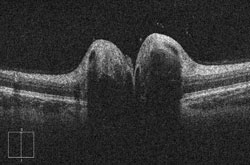 Optic disc drusen. Note the dramatic elevation to the nerve head. |
Tilted discs usually show as elongated optic nerve heads with a prominent choroidal crescent in the direction of the tilt. The tilted margin on the optic disc in the direction of the tilt is usually blunted (rather straight) to some degree.
Situs inversus of the optic nerve is a congenital condition of the optic nerve being turned 180°. The result is that the optic disc vessels emanate from the temporal region of the disc (rather than the usual nasal location), spread in a nasal direction, then turn toward the temporal region of the retina. The nasal margin of the optic disc, which is tilted nasally, is somewhat truncated. The temporal disc margin may have a thin elevated neural rim (not commonly seen in normal optic discs). The nasal tilted disc can produce bitemporal defects (especially on frequency doubling technology) that can mimic visual field defects of a pituitary adenoma, but they will not respect the vertical meridian.
Optic pit is seen as an oval area of no information. This is due to the instrument not finding an anterior or posterior surface reflection in the block scan, ILM or RPE layers. The optic disc will have a large and deep cup with the pit in it (large cup down to even the RPE layer). The optic disc is often larger than average.
In optic neuritis, most of the optic disc is elevated (except for the far temporal margin). There is no or minimal cupping in the RPE layer. The cupping is likely made much smaller by the internal edema caused by the neuritis.
With papilledema, most of the optic disc is elevated, except for the far temporal margin. There may be a small and irregular or regular round cup in the RPE layer, depending on degree of edema. A small irregular cup will return to a round regular cup with resolution of the edema. A partial or complete encircling fluid ring can be seen as an irregular trough in the RPE layer, and this, too, will dissipate with less optic nerve edema. Visual fields may show an enlarged blind spot or other central defects. The cupping is still present even in the more involved stages, and this is likely due to the edema occurring primarily in the peripheral optic nerve close to the subarachnoid space. – William Jones, OD, FAAO
References:
- Fugjimoto JG, Bouma B, Tearney GJ, et al. New technology for high-speed and high-resolution optical coherence tomography. Ann NY Acad Sci. 1998;838:95-107.
- Huang D, Swanson EA, Lin CP, et al. Ocular coherence tomography. Science. 1991;254:1178-1181.
- William Jones, OD, FAAO, is a member of the Primary Care Optometry News Editorial Board. He can be reached at 1828 Conestoga, SE, Albuquerque, NM 87123; (505) 293-7347; wjones556654@comcast.net.
- Disclosure: Dr. Jones has no financial interest in the products mentioned, but Carl Zeiss Meditec sponsors him for lectures. He is a paid consultant for Optos.
 These Panoramic 200C images (Optos, Marlborough, Mass.) show optic disc drusen in the left eye more than the right in a 23-year-old man. His visual acuity was 20/25 (20/20 pinhole) in each eye; pupils were 4.25 mm, round, 3+ reactive; and there was no afferent pupillary defect. Applanation tonometry was 16 mm Hg OD and 15 mm Hg OS. There was no cupping in either eye.  Optic disc drusen can be seen here with nearly overall elevation in the right eye (except for temporal disc margin) due to large drusen spaced close together. Irregular elevation is seen in the left eye due to more widely spaced drusen.  OCT line scans show buried drusen and elevated optic nerve heads.  Retinal nerve fiber layer scans show retinal nerve fiber thickness in all the colors with some thinning of RNFL due to atrophy of neurons from local compression of the drusen. There is a marginal degree of symmetry of 72% due to the unequal loss of neurons in each eye. Note that the disc area is 2.51 mm2 OD and 2.98 mm2 OS, which is larger than the average size of 1.80 mm2. This is due to the lateral expansion of the nerves from the space-occupying drusen. 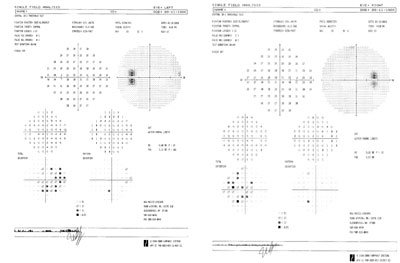 Humphrey visual fields (Carl Zeiss Meditec) show enlarged blind spots. |
 This 67-year-old man had a temporal tilted disc with temporal choroidal crescents. These Panoramic 200C images show the blunted temporal margins of the disc and a floater inferior to the right optic disc. His visual acuity was 20/20 in each eye. Intraocular pressure was 15 mm Hg OD and 15 mm Hg OS. His pupils were 3 mm, round and 4+ reactive with a negative afferent pupillary defect. Optic disc cupping was 0.4 V X 0.45 H in each eye, but this is difficult to measure due to the tilting of the optic discs. The patient had normal Humphrey visual fields. 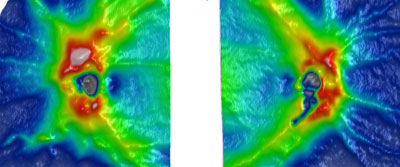 These images show temporal tilted discs with truncation of the temporal disc margin. The choroidal crescent can be seen at the small blue area just temporal to the discs. The inferior narrow arc of dark blue is an artifact from the failure of the scan to find the RPE layer and, thus, is represented as a thinner area of retina.  Note that the temporal disc margin has an elevated wall, which is fairly unusual in occurrence. This view is from temporal to nasal (front to back). 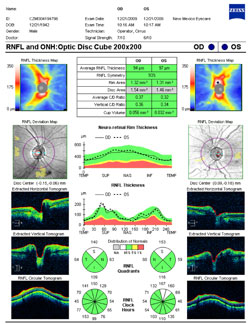 The RNFL appears to be essentially normal, the optic disc sizes are small at 154 um OD and 146 um OS (tilted discs are usually small in area), and the symmetry is good at 93%. |
 This 23-year-old man has situs inversus of the optic nerves. These Panoramic 200C images show that the central disc vessels emanate from the temporal disc area, spread nasally and then hook back temporal. Note that the nasal disc margins are blunted and there are nasal choroidal crescents in the nasally tilted discs. The patient's visual acuity was 20/25 (20/20 pinhole) in each eye. His pupils were 4.25 mm, round and 3+ reactive and had no afferent pupillary defect. Applanation tonometry was 16 mm Hg OD and 15 mm Hg OS. Cupping was 0.4 OD and 0.25 OS. 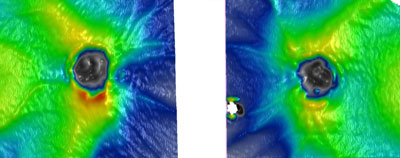 Note that the optic discs have a nasal tilt, with the nasal disc margin being truncated. The RNFL are in good condition with plenty of green color. The small area of no information is due to a floater in the left eye.  Note that the temporal disc margin has an elevated wall, which is unusual in occurrence. This view is from temporal to nasal (front to back). 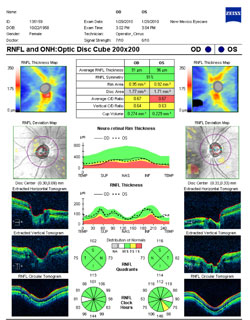 The RNFL is essentially normal, the optic disc sizes are considered average at 1.77 mm2 OD and 1.71 mm2 OS, and the symmetry is good at 91%. Note that the nasal disc margins are somewhat blunted in the nasally tilted discs.  Note the bitemporal defects due to the bilateral nasal tilted discs. |
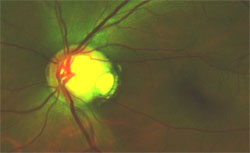 This 38-year-old woman had an optic pit in the temporal region of the optic disc, as shown in this Panoramic 200C image. During an evaluation for glaucoma, her visual acuity was found to be 20/20 in each eye. Her pupils were 4.5 mm, round and 4+ reactive, with no afferent pupillary defect. Applanation tonometry was 16 mm Hg OD and 15 mm Hg OS. Cupping was 0.55 OD and 0.8 OS. 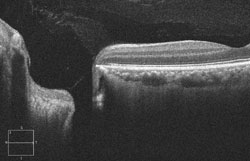 OCT line scan showed the temporally located optic pit. 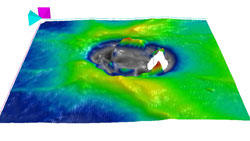 An optic pit is seen as an area of no information because the instrument cannot find the ILM or RPE layers. The RNFL is indicated to be in good condition by showing a lot of green color.  An optic pit is seen as an area of no information because the instrument cannot find the ILM or RPE layers. 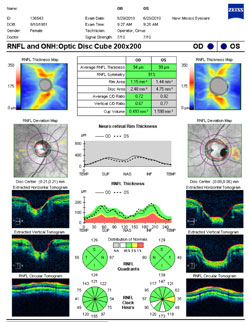 The optic disc cube scan shows a large optic disc of 4.75 mm2 with the pit. The other optic disc is a little larger than average (1.8 mm2) at 2.48 mm2.  Humphrey Matrix (Carl Zeiss Meditec) visual fields show no defects in either eye. |
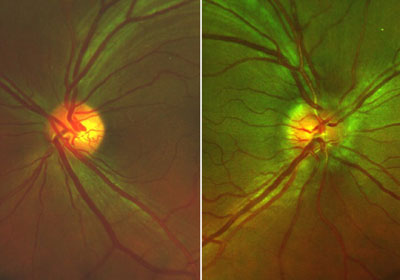 Acute optic neuritis is seen in the right eye of this 41-year-old woman with Panoramic 200C. Note the small cup in the right eye as compared to the left eye and the indistinct disc margins and dilated veins. Upon evaluation for optic neuritis, her visual acuity was found to be 20/50 (20/40 pinhole) OD and 20/25 (20/20- pinhole) OS. Her pupils were 6.5 mm, round and nonreactive (dilated). Tonometry was 10,11 mm Hg OD and 11,11 mm Hg OS with applanation.  Swelling of the right optic disc can be seen. 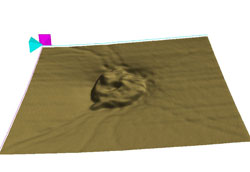 The right optic nerve is shown at the level of the RPE. Note the irregularity of the nerve and small cup from internal edema. 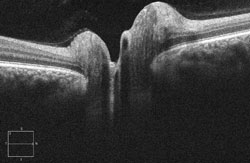 This OCT line scan shows elevation of the optic nerve head.  This RNFL and optic nerve head scan show that the optic nerve and the adjacent retina are swollen. 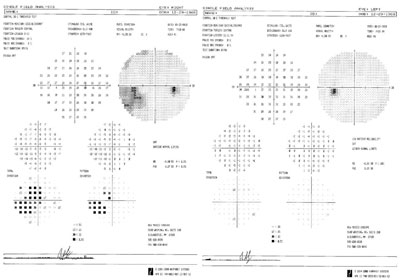 Humphrey visual field test shows defects in the right eye. |
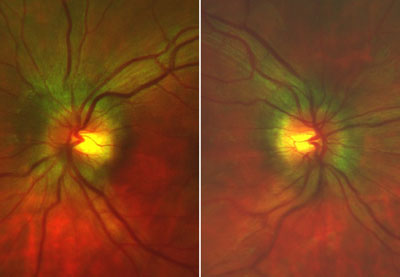 These Panoramic 200C images show bilateral papilledema in a 17-year-old female. Note the indistinct disc margins and dilated veins. The patient was sent for evaluation of papilledema due to pseudotumor cerebri. Her visual acuity was 20/20 in each eye. Her pupils were 7 mm, round and nonreactive (dilated). Noncontact tonometry was 11 mm Hg OD and 15 mm Hg OS. Cupping was 0.35 OD and 0.3 OS.  Note the elevated optic nerve heads. The small area of no information is due to a floater in the left eye.  Note that the optic cups are small and irregular and that there is an irregular ring of edema around the nerves. There is also some cupping. These images were taken July 13, 2010. 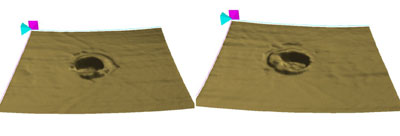 These images were taken Sept. 16, 2010. Note that the optic cups have returned to a larger size and are mostly round. The ring of edema around the nerves is smaller.  RNFL scans show swelling on July 13, 2010. RNFL thickness is high on the comparison scans, the disc areas are 220 mm2 OD and 242 mm2 OS, cup volume was 0.052 mm2 OD and 0.066 mm3 OS, and the average RNFL thickness was 252 µm OD and 215 µm OS. The black areas on the RNFL thickness maps and RNFL deviation maps of July 13 are artifacts. There was improvement on Sept. 16, 2010. RNFL thickness is normal on the comparison scans, the disc areas are 222 mm2 OD and 235 mm2 OS, cup volume was 0.220 mm3 OD and 0.199 mm3 OS (both have increased), and the average RNFL thickness was 107 µm OD and 102 µm OS (both have decreased). 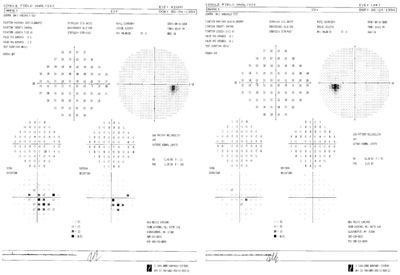 Humphrey visual field test shows central defects greater in the right eye than the left. |

